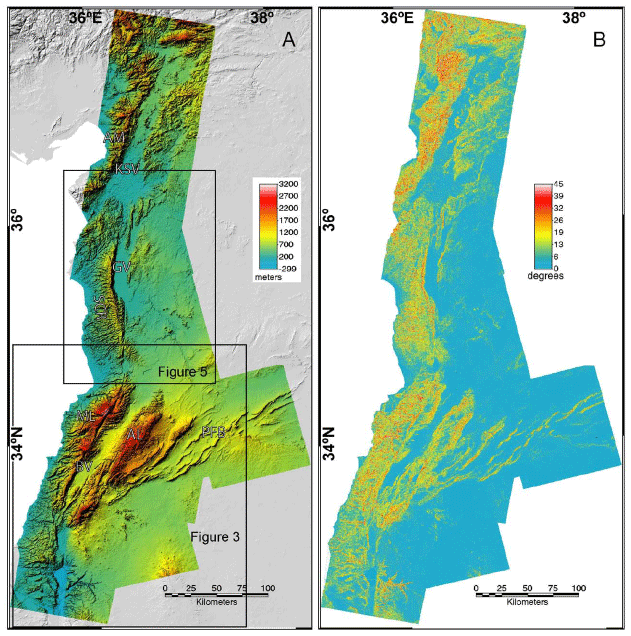
Evidence of long-term, late Cenozoic uplift, as well as strike-slip faulting, is revealed by topographic and geological features along the northern 500 km of the Dead Sea fault system (DSFS)—the transform boundary between the Arabian and African plates in the eastern Mediterranean region. Macro-geomorphic features are studied using a new, high-resolution (20 m pixel) digital elevation model (DEM) produced by radar interferometry (InSAR). This DEM provides a spatially continuous view of topography at an unprecedented resolution along this continental transform from 32.58 to 388 N. This section of the left-lateral transform can be subdivided into a 200 km long Lebanese restraining bend (mostly in Lebanon), and the section to the north (northwest Syria). Spatial variations in Cenozoic bedrock uplift are inferred through mapping of topographic residuals from the DEM. Additionally, high altitude, low-relief surfaces are mapped and classified in the Mount Lebanon and Anti Lebanon ranges that also provide references for assessing net uplift. These results demonstrate an asymmetric distribution of post-Miocene uplift between the Mt. Lebanon and Anti Lebanon ranges. Antecedent drainages also imply that a major episode of uplift in the Palmyride fold belt postdates the uplift of the Anti Lebanon region. North of the restraining bend, the Late Miocene surface is preserved beneath spatially extensive lava flows. Hilltop remnants of this paleosurface demonstrate Pliocene-Quaternary uplift and tilting of the Syrian Coastal Range, adjacent to the DSFS north of the restraining bend. This late Cenozoic uplift is contemporaneous with strike-slip along the DSFS. Geometrical relationships between folds and strike-slip features suggest that regional strain partitioning may accommodate a convergent component of motion between the Arabian and African plates. This interpretation is consistent with regional plate tectonic models that predict 10–258 of obliquity between the relative plate motion and the strike of the DSFS north of the restraining bend. We suggest that this convergent component of plate motion is responsible for uplift along and adjacent to the DSFS in the Syrian Coastal Range, as well as within the Lebanese restraining bend.
Click here to view a PDF of the post-print
This paper was published in Earth and Planetary Science Letters by Elsevier Science. Elsevier Science retains the copyright to this paper.
Figure 2. (A) Shaded relief image produced from the 20 m pixel DEM of the northern DSFS. (B) Slope map derived from the DEM. Abbreviations: PFB=Palmyride Fold Belt, ML=Mt. Lebanon, BV=Bekaa Valley, AL=Anti Lebanon, AM=Amanous Mountains, SCR=Syrian Coastal Ranges, GV=Ghab Valley, KSV=Kara Su Valley.
